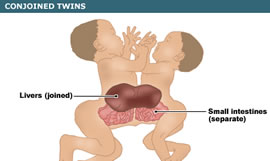Difference between Joined and Conjoined
Key Difference: Joined is used to refer to a link or a connection. Conjoined is also described as a synonym to Joined, specifically in the form of ‘joined together’. However, it is less frequently used than joined. Conjoined is also used to describe a combination. Conjoined is often used in context to conjoined twins; two babies that are born physically connected to each other.
 Many people must be familiar with the word joined, which is used to refer to define a link or a connection. For example - He joined a political party. In this sentence, ‘joined’ is working as a connective term for the person and the party. We often use ‘join’ in our day-to-day lives. However, a few people only know about another similar term – conjoined, as it is mainly used in context to conjoined twins or matrimony. The holy matrimony is associated with linking of two people forever. Therefore, this joining together of two persons in the holy matirimony is often used to define conjoined.
Many people must be familiar with the word joined, which is used to refer to define a link or a connection. For example - He joined a political party. In this sentence, ‘joined’ is working as a connective term for the person and the party. We often use ‘join’ in our day-to-day lives. However, a few people only know about another similar term – conjoined, as it is mainly used in context to conjoined twins or matrimony. The holy matrimony is associated with linking of two people forever. Therefore, this joining together of two persons in the holy matirimony is often used to define conjoined.

Conjoined twins refer to the twins who are physically united at birth. Thus, the word conjoined is mainly used as an attribute for these kinds of twins. Conjoined also defines an association like the one defined by the word ‘joined’. Conjoined is also referred to as joined together. It means that the components that are being joined in conjoined type of relation, all distinct components are given equal weightage or importance. However, in case of joined, the weightage of one may differ from the other. The prefix of co- before the term joined defines that the components are closely associated to each other.
Comparison between Joined and Conjoined:
|
|
Joined |
Conjoined |
|
Origin |
From Old French joindre, from Latin jungere to yoke. |
From Old French conjoindre, from Latin conjungere, from jungere to join. |
|
Definition |
Joined is used to refer to a link or a connection. |
Conjoined is also described as a synonym of Joined, specifically in the form of ‘joined together’. However, it is less frequently used than joined. In Grammar, it is used to define joined as coordinate elements, especially as coordinate clauses. |
|
Examples |
|
|
|
Type |
Verb |
Verb |
|
Form |
Simple past and past participle of join. |
Simple past and past participle of conjoin. |
Image Courtesy: anashclinicalresearch.com, news.bbc.co.uk









Add new comment